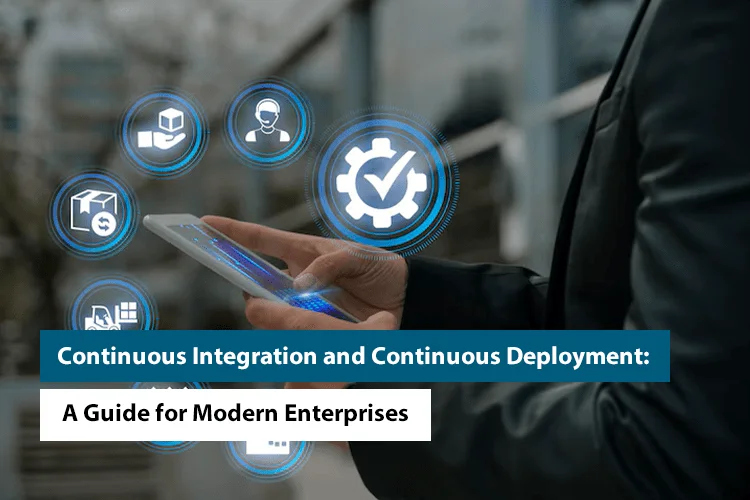Continuous Integration and Continuous Deployment: A Guide for Modern Enterprises

Are you aware that an organization with automatic CI/CD pipelines deploys more code up to 200 times than one that has nothing to do with these activities? The rate of evolution in the world of business today is outrageous. If slow software delivery is accompanied by low standards, it can be disastrous. Developers need to supply software quickly, precisely, and without any issues. In terms of competition, a business that does not engage in this space will simply be doomed.
So here comes Continuous Integration and Continuous Deployment. These processes allow for development, testing, and later deployment to be done automatically. They enhance the simplicity and speed with which software can be delivered. For enterprises of modern times, the question of whether to adopt CI/CD or not is no longer relevant, it has become a matter of necessity.
We will discuss how the right CI/CD procedures can boost your business growth in this guide, but first allow us to explain the importance of such an approach as well as its basic concepts
What is CI/CD?

In least terms, CI/CD is an acronym for Continuous Integration and Continuous Deployment which is part of DevOps that emphasizes automation and speed without compromising on quality.
Continuous Integration: Developers commit code changes over and over again and these changes are then subjected to automated testing in a sandbox.
Continuous Deployment: Once the code has passed the necessary testing stages, it is automatically put into production without any interruptions.
Overall, CI/CD contributes to the increased responsiveness of IT service delivery. It minimizes revamping, enhances testing almost all, and gives quality outputs.
In cases where a company specializes in software and web development services, CI/CD standardizes all tasks done in every project undertaken.
Why are CI/CD Strategies Relevant to Contemporary Businesses?

The focus points of almost all modern enterprises are speed and growth. And implementing CI/CD methods can bring about drastic changes to the business models regardless of the organization size.
Shorter Time to Market
CI/CD upskills your processes by reducing the amount of work and enabling independent systems to test and implement features and products. This reduces the time spent on the delivery of updates.
Reduced Number of Bugs
Testing software consistently means that bugs will be discovered and fixed before they become a major problem. Removing those issues before release creates a more stable final product.
Reduced Overhead
The traditional ways of deploying and testing a product require a significant amount of finances and labor. Through the processes of CI/CD, these problems are solved easily and requirements and additional workloads are lowered significantly. As a result, this leads to a reduction in time and cost.
Increased Customer Relations
Fewer complications and a faster rate of delivery result in a significant improvement in customer satisfaction. This also in turn reduces the chance of clients using the services of your competitors.
Unified Team
CI/CD naturally fosters cooperation between developers and testers with operations teams which simplifies a lot of processes within a company raising overall efficiency.
For example, at Imenso Software, we use CI/CD strategies when doing offshore software development, allowing us to deliver projects rapidly and reliably. Our clients always receive the software when they want it, with no delays or defects.
Key Differences Between CI and CD
CI and CD are often taken to have similar functions but in reality, perform different functions.
| Aspect | Continuous Integration | Continuous Deployment |
| Focus | Integrating and testing code changes | Delivering code to production |
| Automation | Testing is automated | Deployment is automated |
| Frequency | Happens multiple times a day | Happens after every successful CI |
| Outcome | Code is error-free and ready to ship | Code is live for end-users |
In simpler words, CI makes sure that the changes in the code occur in an automated environment without bugs. The CD makes sure that the updates will be available to the customers in the shortest time possible.
Continuous Integration in Depth

What are the Key Stages of CI?
Code Commit
Developers would write and push the changes in codes to the central repository, Git. Such frequent commits help teams to come up together while merging codes and avoid integration issues.
Automated Build
The code is built into the application automatically. In this step, potential problems, broken dependencies, or dependency components that are not fulfilled get highlighted.
Automated Testing
Automated unit tests, integration tests, and in some cases even functional tests are initiated. This step confirms that the code is satisfactory and that new changes do not remove any already completed functions.
Feedback
If there is an error or a test is not successful, the developers are immediately warned of such fact. Thus, feedback is of tremendous importance and enables teams to solve problems easily and in no time.
What are the Benefits of CI?
Minimizing bugs
By way of early detection of bugs through continuous testing, CI allows for bugs that are easy to deal with, to be flagged when they occur instead of costs being excess in fixing them later on.
Quicker development cycles
Due to the incorporation of automation, manual testing time will be significantly less. The ‘automation’ will allow the developers to write more code instead of conducting tests thereby innovating more.
Lessened integration problems
Regular merging of the codes will eliminate major integration problems or incorporation compatibility too when the members are collaborating.
Consistent code
It aims that even if the codes of the software are added and even multiplied, the software will still serve its purpose as expected.
For companies that offer custom software development services, CI guarantees swift and seamless conduct of development and processes.
Continuous Deployment in Depth

Key Stages of CD
Approval
The CI process validates the code, and then the system deploys it. This step is to ensure that changes made to the code base are waste-free and of high quality.
Automated Deployment
The deployment process is set up to automate code delivery to the production phase without needing any operator interaction. Automation helps reduce errors to the minimum and guarantees that a company’s product is given out at uniform grade across the board.
Monitoring
After deploying the application, system admins supervise the application environment for its proper working, safety, and dependability as well. Monitoring means checking address DNS available functionality and the availability of operating web pages including the number of users on the site.
Rollback
When a significant fault in the system is established before or after deploying the code, rollback is performed. i.e. providing a previous working state of the application to prevent causing problems to the end users of the system.
Benefits of CD
Speedy Deployments
Businesses are now able to integrate rapid updates and new features into their system through the use of automated deployment techniques, enabling their clients to receive rapid resolutions for issues within the system.
Reduced Manual Effort
Removing the need to do manual deployment saves time, makes it less likely for mistakes made to be human errors, and enables dev teams to be more focused on programming and inventing.
Better Customer Response
Constant features and a moderate level of updates on a product enable clients to have access to the improved context of a product making it attractive.
Continuous Improvement
Automated deployment allows clients to give feedback on issues and requirements for redeployment. Problems can be found, fixed, and remounted quickly on the system allowing the product to improve.
Imenso Software adopts the CI/CD methodology across its mobile app development services and other services. As a result, there is reliability in the delivery of software with the risks of downtime being minimal.
What Happens When CI/CD is Implemented?

In any organization where software development teams enable CI/CD processes, improvements are noticed:
Developers work on new features instead of working on resolving existing bugs.
Testers can focus on more complex testing or use different testing methods instead of doing the same thing over and over again.
Business Owners work with releases that take less time to produce, are of better quality, and cost less to make.
Clients receive applications that perform properly and require little time to receive updates.
For instance, firms engaged in offshore software development will implement updates several times during the day. This helps them remain competitive and satisfy customers’ requests.
How to Implement CI/CD?

- Make the Right Selections: The major ones are Jenkins, GitLab CI/CD, CircleCI, Travis CI, and Azure DevOps. These preferably suit remote teams.
- Take Baby Steps: Begin with smaller projects aimed at trying out CI/CD pipelines before extending them throughout your enterprise.
- Automate Everything: Eliminate all physical work by automating the processes of code building, testing as well as deployment.
- Use of Version Control: Keywords observe that Git is one platform that enhances developer collaboration through easy merging of changes and version management.
- Keep Under the Radar: Utilize these tools to pinpoint and fix the problems without incurring delays.
- The Safety Aspect: Embedding security features into the CI and CD pipelines can prevent unsecured access or breaches even if the segmentation and other controls fail.
- Collaboration is the Key: Ensure the developers, testers, and operations teams integrate into one single team for easy workflows.
These best practices can be followed by companies to realize CI/CD integration effectively. In the case of Imenso software, we also assist our clients in the migration and integration of CI/CD Pipelines which enhance their custom software development services.
Difficulties and Aspects to Think About

Adoption of CI/CD patterns brings with it a variety of advantages, it does however have some drawbacks:
Initial Setup:
Setting up CI/CD pipelines requires careful planning and time. You need to define workflows, set up infrastructure, and integrate tools properly. For small teams or projects, this can feel overwhelming at first.
Team Training:
Developers, testers, and operations teams may need training to adopt new tools and workflows. Adjusting to automated processes can take some time and effort.
Tool Integration:
With so many CI/CD tools available, choosing the right ones for your needs can be challenging. Tools like Jenkins, GitLab CI, and Azure DevOps must align with your existing environment.
Continuous Monitoring:
Automation helps deliver faster results, but continuous monitoring is required to catch performance issues, security breaches, or bugs post-deployment.
Cultural Shift:
Implementing CI/CD is not just about tools but also about changing team culture. It requires fostering collaboration and encouraging a mindset of continuous improvement.
First Automation Preparation:
It is crucial to state that setting up CI/CD pipelines is a time-consuming and intricate process. You need to define workflows, set up infrastructure, and integrate tools properly. For smaller teams or a small project at first, this can be somewhat off-putting.
Requisite Qualifications of Employees:
IT Personnel development (e.g. Developers, Testers, and Operations Teams) may require some amount of training to effectively incorporate new tools or automation into existing workflows. It might take a little bit of time and work to adjust when shifting to an automated process.
Receiving the Correct Tools:
It can be somewhat of a challenge to determine which tools are most ideal for your tedious processes when there are so many CI/CD tools available in the market, Jenkins, GitLab CI, and Azure would have to work with the environment you are in.
A 24-hour Focus on the Changes Made:
Although automation leads to more rapid results it, unfortunately, does not eliminate the need for continual vigilance in order to monitor for problems with the performance or security violations or issues within the software after it has been deployed.
Multiplicity in the Process:
To successfully implement CI/CD, all members of the team need to be willing to change the way they think, it is not simply a variety of tools that are required, but teamwork and marketing within the company must also be improved.
Nevertheless, these challenges can be easily brushed aside, given one has the right partner and process in place. Imenso Software teams nail the CI/CD handoff with specific solutions that meet the client’s expectations. A dedicated expert team makes sure that no errors happen during the build process which accelerates business growth.
Also Read:
A Guide to Hire Software Developers in India
Top 10 Programming Languages for 2025
How Custom Software Turns Boring Processes Into Revenue-Generating Engines
Looking Ahead
CI/CD is the new norm for modern organizations. It increases the quality of the software and delivers it in a shorter period and for a lower price. Whether you are targeting mobile application development services, custom software development services, or even offshore software development services, the introduction of CI/CD into your business practices will set you ahead of the competition.
This is why we at Imenso Software assist companies in making the CI/CD integration flawless. Our professional team ensures that customers receive high-quality software within a short period of time. You can always trust us because we have built a great reputation, and we have provided high-quality services to many clients regarding the software development process. Have a look at our portfolio here!
Are you ready to change the face of your software delivery? Contact Imenso Software and elevate your business to a higher level!
Want more information about our services?
Similar Posts

Hiring Offshore Software Companies In 2022? Here Are The Top Models To Pick From
Tech businesses face the pressure to constantly evolve their products and services to get to the top of the profit making pyramid. CEOs and business owners are always on the lookout for business strategies to have the maximum impact with borderline investment. ...

Node.JS Vs Python: Pick the Best Backend Technology in 2022
The battle between Node.js and python for the best backend technology is always on. One is old and established while the other one is new and trending. Which will win the war? Let’s dive in. Picking the right technology stack is pivotal for a web application project. The frontend and backend technology combination decides the project cost, […]...

ReactJS vs AngularJS vs VueJS – An extensive comparison
While the JavaScript frameworks continue to dominate development space, all the JS frameworks do not stand equal in respect of fulfilling necessity of all projects. While React JS and Angular JS continuously get support from developers worldwide, according to many the small and neat team of VueJS actually helped the framework to keep them the […]...









